In Parts 1 and 2 of this series I looked at some aspects of what it’s like being a freelance designer / engineer / maker, and some of the things I’ve learned along the way. Lots of freelancers have blogs, and sites such as Freelance Switch and Sologig News draw together some very interesting (and diverse) people and advice. I did an interview for Sologig News a few months ago.
One of the things that I’m often asked, mainly by design students intrigued by the idea of working for themselves once they graduate, is just how to go about doing it: how to raise your profile, and find the right projects to take on. Having really only been marginally successful in this area, I decided to interview Ben Wilson, with whom I’ve worked on a couple of projects, and who’s achieved a great deal working for himself in this field. Ben’s blog, along with his brothers, is a great photostream-style travelogue of interesting products, vehicles, graphic design, places and influences.
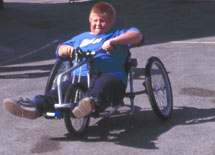
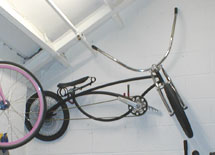
Left: The Tilting Trike in arm-propelled mode. Right: The Downlow Lowrider
DL: What are some of your highest profile projects?
BW: I’ve done lots of different projects – I think I’m probably best known for the work I’ve done in transportation and especially in bicycles and bicycle-related design.
A project that won some awards was the Tilting Trike which started off as a project at the Royal College of Art and then was taken on as a research project within the Helen Hamlyn Research Centre. That won a few awards and got quite well known. Before that, I was known as ‘Bicycle Ben’ and people thought that was, sort of, all that I did. About nine or ten years ago, I designed a low-rider recumbent bicycle – at the time, that attracted a lot of attention and press, so I was very well known for that. But since then, I’ve gone on to work in lots of different areas – interior, product, industrial design.
I think another project that’s quite well known – well, sometimes it’s not accredited to me so much but I was very much involved from the concept all the way through to production – is the Manfrotto FigRig, developed and patented worldwide and manufactured by Manfrotto. There’s that product and there’s the work I’ve done with flat-pack furniture – the Chairfix. I suppose they’re the highest profile projects, but they’re by no means all the projects that I’ve done. They’re the ones that stick out.
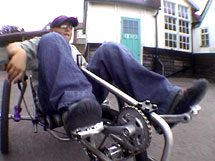
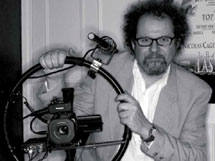
Left: The Tilting Trike in foot-pedalled mode. Right: The Manfrotto FigRig, with Mike Figgis
You’ve certainly been involved with a lot of projects. I suppose other young designers, thinking they’d like to go into business for themselves, would be especially interested in how you got started doing this. What made you want to go down the path of working for yourself as opposed to, say, taking a ‘normal’ design job?
Probably because I couldn’t get a job in product design. I’ve always had a reasonable entrepreneurial streak within me – I think that probably stems from my parents. They were both self-employed, they were both designers, so I was immersed within a kind of very creative family and household. But also, seeing the way they acted and talked on the phone and worked – I think there was that, too. It kind of stemmed from trying to get experience, finding it very difficult to get experience, and especially experience that I wanted to gain.
And, by default, I suppose: I created this object, the low-rider bicycle. I’d sold one before I graduated, so I realised there was a market for it. I technically could manufacture them – I made it myself, I prototyped it and made it myself so that was me, that’s what I had to promote myself, so in that respect, I could say “Can you make it? Yes I can”. There wasn’t one day when I said “Let’s start Ben Wilson Design”.
Then I went back to college, but even when I was doing my MA at the Royal College of Art, I was always doing a little bit here and a bit there – freelance and bits and pieces.
That’s interesting how you ‘fell’ into working for yourself like that. But a lot of your projects seem to have led on to others – you’ve come to the attention of someone because of one project, or a company has thought “That’s good; we’ll get him to do something.” Would you say that’s an important way of finding new work, as a freelancer?
Definitely. I’d say the stepping-stone effect is in everything. Every project that I do is gearing me up for the next. The research, or the techniques, will be used in something that’s done later on. So, yes. It gets infuriating when people – a bit like the category ‘Bike Ben’ – just expect me to do bikes. I love doing bikes but to a certain extent, that’s not all I want to do all the time. But just like in anything, if someone becomes a kind of specialist… say I needed some upholstered furniture, it would be good for me to talk to some people who have quite a lot of experience doing that, because I’d be halving the time by learning from their experience. So, always that’s the way. You tend to become specialist; although I haven’t tried to become a master of anything, hopefully I’ve build up good experience in many different areas.
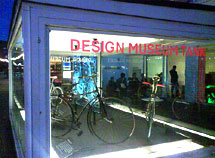
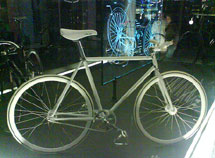
FIXED, Ben’s exhibition in London’s Design Museum Tank focuses on fixed-gear bikes
So how have you gone about getting known? You’ve got some very high profile attention from, the Design Museum, the British Council, and so on. Did this come about through you approaching them, or through them approaching you, or a mixture?
A mixture. But I think predominantly it’s the snowball effect. You start off with one thing – take my bicycle. Through my brother, there was a space available in Farringdon where I could show the bicycle, in an area where there were a lot of publishing houses. It gained some press attention, and once one article comes out in the press – just like if something goes on a blog – it spirals, and it spider-webs, and it goes out everywhere. And I think that’s an interesting side of how ideas get spread.
So it’s worth doing that? It’s worth young designers making the effort to get their projects out there so that people see them.
Very much so. I’m a really strong believer in getting stuff out – to the extent where I’m asked by some companies to do pure brand work, looking at developing their brands for them, which I find very interesting. I’ve worked for different ad agencies – you might see that as very different to my other design, but it’s not really, it’s all creative output and it’s a mindset of how you think. It’s important to promote yourself and be as creative with how you market your identity, who you are and what you want to say about yourself. I don’t show at Milan: it’s mainly because I haven’t really been asked to. If someone wanted to fund me to do something for Milan, I would.
Take London Design Week, coming up soon. As far as I know, I’m not showing anything. It’s not necessarily out of choice – although it’s a great time and place to show your work, it’s also a saturated market. There could be better times to show work, for different audiences as well. That’s nothing against the idea – I have had exhibitions at that time, but I think it’s about taking opportunities when they come, and utilising them.
You do a lot of self-directed projects as well, don’t you – your own projects alongside work that clients have asked you to do? Would you say it’s definitely worth a freelancer trying to do that?
Absolutely. Aside from the potential revenue if the project’s successful, it’s keeping your mind active on new challenges. There’s that impetus that shows through in college or university projects – why you’re interested in something, why you want to investigate it – but then when you leave, many people almost drift into often mind-numbing design work. I know and probably you too know people who are in the creative industries but find it really difficult to rekindle the excitement they used to have about design. But even work for clients may feed into something that I can use on one of my own projects.
Chairfix is a good example of a self-initiated project. It came about because I was fed up with building bicycles because of the time that they took, and I wanted to exploit a process [CNC technology], and within that, I developed an object, and then wanted to show it to the public. So I organised my first show, up in the West End at Aram, and got a really good response, and from that I launched that product. I sold a considerable amount of them, and made a significant financial gain – I don’t want to talk about figures but I think taking responsibility and full ownership of a product yourself does mean that you don’t have to deal with poor royalties. You don’t have to sell so much of something to claw back some of the R & D that you put in. What it taught me as well – it makes you business savvy, it makes you go into negotiations, it makes you into discuss things with clients on a different basis.
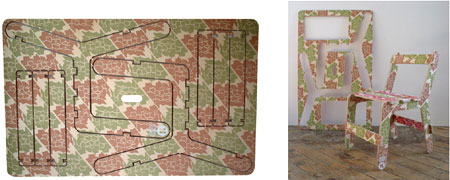
A number of graphically customised versions of Chairfix were made available at the launch, including this by Ben’s brother Oscar
That’s something a lot of young designers have no experience of, and haven’t been taught. It’s difficult to get that kind of knowledge unless you actually do it practically yourself, with an actual business.
Very much so. And also – say you do have some experience within a consultancy and are starting to do some work for yourself. The jump is from working with big corporate companies, dealing with big contracts with big money, to that middle ground. Even if you’re not employing ten people, your turnover needs to be a reasonable amount just to keep your head above water. A global brand is not going to pay me [as a self-employed designer] as much as they would an established design studio with huge overheads. But they’re buying a different sort of thing. I think you have to make sure that you place yourself correctly within that market.
So what would your advice be to a young designer, perhaps, just starting out from university or from college, or still there maybe, with this dream of working for him or herself? Is there any simple advice you could give, other than “Just get on with it, just do it”?
You’ve got to do it. If that’s what you really want you’ve got to think a lot about that dream, because it takes over your life, it’s incredibly hard work, but it’s incredibly rewarding. Those are the realities of being self-employed. That aside, you need to think about who you are, what you’re doing, and why you’re doing it on your own, and how you’re going to brand that, how people are going to perceive what you’re showing. The opportunities are really good – it’s a lot easier now than when I started off. Like going to a photocopy shop and sending information in the post – things are different now, you can send an e-mail and hit so many different people.
You really have to go for it. I’ll never forget one phone conversation – at this time I was working out of my bedroom in my parents’ house – and someone phoned up saying “Can I speak to the managing director of Downlow Cycle Co?” (that’s sort of the title I went under). My mum answered the phone, not pretneding to be my secretary, but said “Yes, I shall just get him for you,” and it was someone enquiring about a really big order. I remember thinking, do I say “Well I’m just a small man in a bedroom, begging, borrowing and stealing to build these bikes,” or do I walk? Maybe he wants to think I’m a big business? I never ever lied, but neither did I tell him that I wasn’t running a multi-million pound corporation. So I think in that repsect, you have to think on your feet.
Also, you have to take opportunities as they come. Be confident and look at the possibilites in lots of different ways. It’s about both running with opportunity, and making your own. People say “Ooh, you’re a lucky person in life”. Certain people say that to me. But I think often, you make your own luck to a large degree. There are always opportunities. There are shops in London that are vacant. If you wanted to rent one for a year it would be a fortune, but if you wanted it for two weeks, you could probably cut a deal with a savvy landlord. There’s certain things like that, that really can work. I think you have to be creative with your own identity, your branding and how you get known as you have to be with the actual products, whatever you’re designing.
That’s some very good advice there, from someone who’s put it into practice very successfully. Thank you very much Ben.